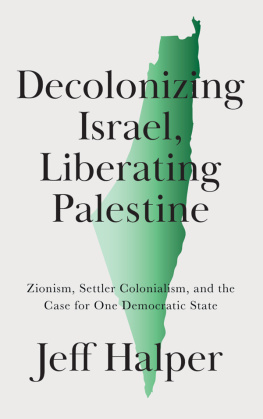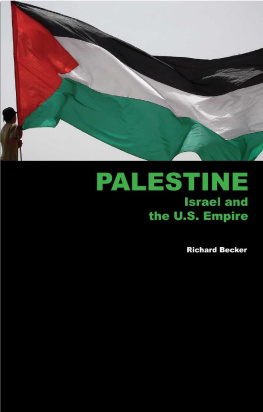A tour de force, based on diligent archival research that looks boldly at the impact of Zionism on Palestine and its people in the first part of the 20th century. The book is the first comprehensive and structured analysis of the violence and terror employed by the Zionist movement, and later the state of Israel, against the people of Palestine. Much of the suffering we witness today can be explained by, and connected to, this formative period covered thoroughly in this book.
ILAN PAPP, ISRAELI HISTORIAN AND AUTHOR
Other books by Thomas Surez
Palestine Sixty Years Later
[Americans for Middle East Understanding, 2010]
Early Mapping of the Pacific [Charles E. Tuttle, 2004]
Early Mapping of Southeast Asia [Charles E. Tuttle, 1999]
Shedding the Veil: Mapping the European Discovery of America and the World [World Scientific, 1992]

First published 2016 by
Skyscraper Publications
20 Crab Tree Close, Bloxham,
Oxon OX15 4SE, U.K.
www.skyscraperpublications.com
Copyright 2016 Thomas Surez
The authors rights are fully asserted. The right of Thomas Surez to be identified as the author of this work has been asserted by him in accordance with the Copyright, Designs and Patents Act 1988
All rights reserved; no part of this publication may be reproduced, stored in a retrieval system, or transmitted, in any form or by any means, electronic, mechanical, photocopying, recording or otherwise, without the prior written permission of the publisher. Nor be circulated in any form of binding or cover other than that in which it is published and a similar condition including this condition being imposed on the subsequent purchaser.
A CIP catalogue record for this book is available from the British Library.
ISBN-13: 978-1-911072-03-4
Cover concept and design by John Chandler and Thomas Surez
Designed and typeset by Chandler Book Design
Printed in the United Kingdom by Latitude Press
The growth of Fascism in Palestine at a time when the liberated nations will put it into its grave is a tragi-comedy.
Physicist Wolfgang Yourgrau, a German Jew who emigrated to Palestine but left in 1948,
in the journal Orient, February, 1943.
CONTENTS
Dedicated to the resilient youth of Palestine,
who from their parents unwavering
struggle for freedom
will build a future of their own choosing.
Acknowledgments
T his book grew out of conversations with Ghada Karmi in the aftermath of Israels Cast Lead attacks against Gaza. Documents I had come across when writing my 2010 book, Palestine Sixty Years Later, raised questions about Mandate-era terrorism that Ghada encouraged me to pursue. This led me to the National Archivesand to the present book. Without her encouragement and assistance, this book would not exist.
I was fortunate to have had very smart people peruse the draft and share their expertiseLaurence Dreyfus academic rigour and acumen; Nancy Elans attention to language and political context; Francis Manaseks organizational perspective as a scientist; Nancy Murrays historical input; John Surez help with detail and cohesion; and my daughter Sainatees tenacious regard for logic and accuracy. My gratitude goes as well to Emily Dreyfus, Mirene Ghossein, Yosef Grodzinsky, Elaine Hagopian, Reem Kelani, Joseph Massad, Sami Musallam, Jamal Rjoub, Rona Sela, Chris Somes-Charlton, Rawan Yaghi, as well as the entire always-helpful staff of the National Archives in Kew.
My publisher Karl Sabbaghs encouragement, trust in my work, and extensive knowledge of the subject all helped make this book a reality. I was fortunate to have Skyscraper Publications bring the book to the light of day, joining such other works on its list as Mads Gilberts Night in Gaza and Karl Sabbaghs own Britain in Palestine.
Three eye-witnesses to events in the 1940s shared their experiences with me. The late Hanna Braun, ex-Hagana member, met with Nancy Elan and me in London in 2007. Max Maxwell, Sgt Maj, 16 Field Security Section, Intelligence Corps, was present after the Austrian train bombing of August 1947, and kindly shared his documents and photos. Ted Steel, who was in Palestine with the British during the last years of the Mandate, spent an afternoon sharing memories, information, and photographs. On 22 July, 1946, he delivered documents to the British headquarters in the King David Hotel and, breaking with his routine of heading straight to the canteen, left the building. As he did, it blew up. He awoke later in an oxygen tent. An unknown well-wisher visited him in the hospital and handed him a few photographs of the bombing as a souvenir, one reproduced herewith. My thanks to Camilla Saunders for making our meeting possible.
During my last two years of work on this book, I was teaching at Palestines National Conservatory of Music, first at its exquisite ex-Ottoman home in Jerusalem, and then at what is arguably its most important branch: Gaza. However, Israel blocked me from ever meeting any of my twenty Gaza-branch violin and viola students face-to-face. Lessons by Skype video, whenever Gaza had electricity, were as close as my students and I could come. I would like to acknowledge these students, who refuse to yield their humanity, their dignity, their resolve, despite the inhumanity thrust upon them.
Among my many West Bank friends and colleagues, I would like to acknowledge in particular violinist Michele Cantoni, a tireless powerhouse of empowering diverse musical life in Palestine, and an unending source of discussion about the region and the conflict; and Mathilde Vittu, professor of music analysis at the Conservatoire de Paris, who devotes herself tirelessly to music and children in Palestine. My thanks as well to my flatmate in Bethlehem, guitarist Pedro Lpez de la Osa, and my colleague across the hall in Jerusalem, violinist Vilde Alns.
To my mother and my late father I owe everything, not least of which was growing up with their sense of universal fairness, of healthy scepticism, and of searching for truth beyond the headlines, that has led me to all that has mattered in my life.
Finally, my partner Nancy Elan was my constant alter-ego, perceptive critic, and idea tester. I could not imagine having written the book without her. In the midst of it all, my topic proved unexpectedly prescient when her activism in the Palestinian cause led its adversaries to come knocking at the door of her professional life.
Illustration credits
1. (27) Mappamundi. Woodcut, published in Lbeck by Lucas Brandis, 1475. Photograph courtesy Jo Ann and Richard Casten Ltd.
2. (41) Landing place, Jaffa. Photograph by American Colony (Jerusalem); marked between 1898 and 1914; negative, glass, dry plate, 5 x 7 in. Library of Congress, G. Eric and Edith Matson Photograph Collection, LC-M32-D-3.
3. (51) Political cartoon, The man of the two wives, in the Jaffa based newspaper Falastin, June, July, or August 1936. Image taken from Pragnell, F.A., Palestine Chronicle, 1880-1950 [Pragnell Books, 2005]. My thanks to Fred Pragnell for his kind assistance.
4. (61) Palestine Broadcasting Service, photograph by American Colony (Jerusalem), Nitrate negative. Library of Congress, G. Eric and Edith Matson Photograph Collection; LC-M33-11118.
5. (78) Arab recruits in Nablus, May 6, 41, Library of Congress, G. Eric and Edith Matson Photograph Collection; negative, safety film, 5 x 7 in.; LC-M34-12055.
Next page











